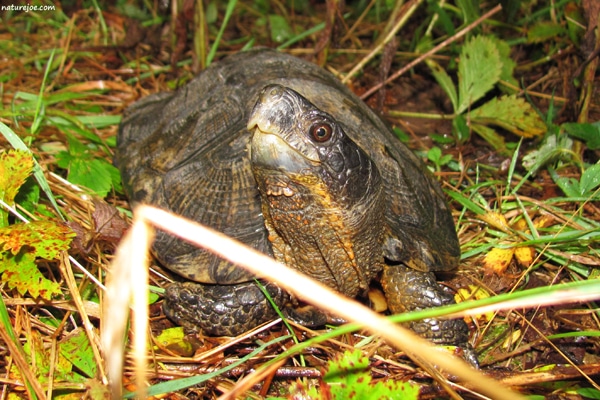Just recently I posted an article concerning the captive care of the wood turtle. Here's a little look at their "wild side." Read M
Just recently I posted an article concerning the captive care of the wood turtle. Here's a little look at their "wild side."
Read More
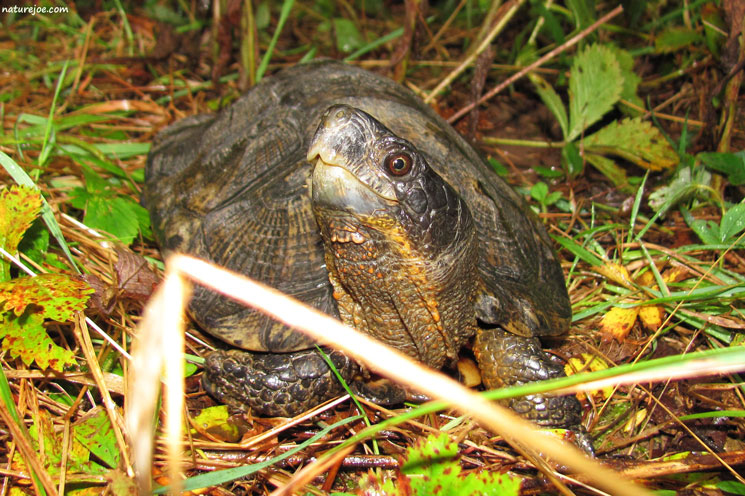
joe myers
I have encountered wood turtles (Clemmys insculpta) in two areas of the country, and back in the 1990s (before I had a camera) I saw these in Michigan, and in more recent years, in Pennsylvania. I am almost tempted to say there are two different subspecies here. First off, the "Midwest" population totally lacks the orange color, and is yellow instead, and are more "round-shelled" it seems, and lay more eggs (up to 15, while the Eastern population usually lays a dozen – with six to nine being more like it). Also the Midwest population seem to show more shell deformity, concerning having extra scutes (scales) on the shell than do the "Easterners," and also lack the variety.
Looking at the Michigan population, they seem to live much more aquatic there, even basking on rocks and logs right along with the map turtles (Graptemys) that live there, and seldom stray far from swamps and old marshy fields. They are much more commonly found in water than the Eastern population, which seems to like it high and dry.
When compared to Pennsylvania, Michigan is very dry and sandy, but the wetlands there are quite common, and the wood turtles seldom stray too far (except at nesting time), and unlike the Blanding's turtle (Emys blandingii) which favors still waters, the wood turtle prefers larger rivers and creeks, as well as the marshy environs that will have you knee-deep (or deeper!) in mud. One time I stepped into quicksand near the town of Big Rapids which was a real shock when in less than half a second I was completely submerged in cold black muck. I was in no real danger, but it did indeed take my breath away! The texture was more like "mud soup," and looked quite harmless when I first stepped into it. By the time I realized there was no bottom under me it was too late! I ended up washing off in a nearby beaver pond and thinking "I'll go through a lot to find a wood turtle!"
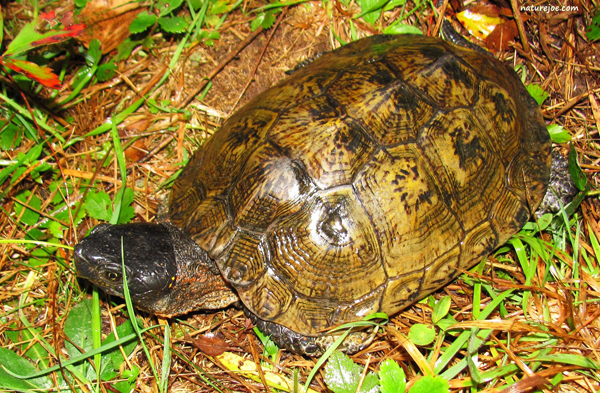
joe myers
Wood turtles usually start their day by basking in the morning sun before going off to feed.
In recent years I have gained a lot of experience with these since I've spent a lot of time in the Pocono Mountains, and here I learned they are quite territorial. Once they establish a home territory they are not inclined to wander too far from it. Also (when compared to the Midwest population), a small mountain stream will do them just fine, as well as an old open field. They seem to avoid marshy areas altogether here but will wander among the reeds if it gets really hot and dry for an extended period of time.
Once a colony is discovered, repeated trips to the area will reveal how the same turtle can be found in almost the exact same spot day after day, and will remain there until the weather conditions change. They start their day by finding a wind-protected spot usually near the edge of a field, often just inside the treeline on top of a clump of dry dead grass to bask for awhile in the morning sun before moving on to feed. Just like the eastern box turtle (Terrapene c. carolina) which is often found near it, they seem to know exactly what's ripe out there, and know exactly where to go to find it. There's nearly always something ripe and waiting for them, and around egg-laying time in early-June they crave those delicious little wild strawberries, and every day they will be seen feeding in the same little patch.
When I encounter a turtle I will photograph it the first time I see it, and after that I will avoid getting too close, or remaining near it for too long, for the fear of making it afraid to return there safely thus depriving it of an otherwise-excellent food source which has probably been used for decades. After the strawberries are about gone, they waste no time going to the mulberry trees, and a mulberry tree in an old field is almost certain to have its resident turtle or two. Fat turtles with purple-stained faces and feet are a part of the Pocono countryside during that time of year.
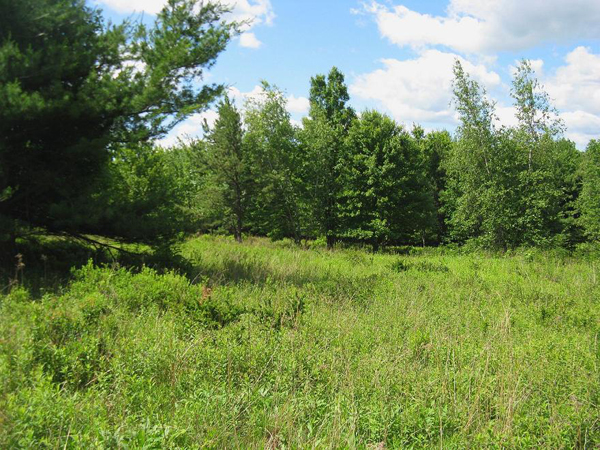
joe myers
This field is prime habitat for the wood turtle.
Soon after the last mulberry has hit the ground they're off to another berry – this time it's the dewberry. There seems to be two kinds and they like them both, The ones that grow in the open fields will really rasp your legs if you are not careful, but the ones with the shiny leaves that grow at the edge of the woods are a bit more harmless (to people that is!), but the turtles seem to like both.
These are a form of "blackberry" that grows almost eye-level to them, and they love them! Anyway as soon as the dewberries are gone, it's off to the blueberries. Many are too far above the ground for them to reach, but leave it to the wood turtle to find the low ones. They will literally crawl up on part of the plant and push it low enough to get at the berries, and along with the black bears and Timber rattlesnakes, they will feed on the blackberries later in the summer (No, the rattlesnakes don't eat the berries, but are there to feed on the small mammals that DO feed on the berries), and later in August they start to work their way back to lower ground. For one, this is usually the hot and dry season, and for two, this is when the apples begin to fall. Along with the yellow jackets and ants, the turtles have another unlimited free food source as the apples fall to the ground, and there they will stay until sometime in September when they seem to turn to more of a "meat" diet in the form of slugs and grasshoppers. Also during the earlier part of summer they often enjoy the bonanza of June bugs as they emerge to start their nightly flight.

joe myers
Trout streams such this are plentiful throughout their range, and are important to their survival.
As you can see, their little world seems to revolve around food – and where to find it, but what about water? Let's take a look. On a typical summer day they seem to enter the water around 4 p.m., and they will crawl right in and submerge for an hour or so. When a male meets a female, courting almost always happens, and sometimes several pairs can be seen in the same little waterhole.
They will enter a creek, river, old water-filled tire track along the edge of a field, a ditch, a puddle in an old road, or just about any other place that holds water for their afternoon soak, and by around 6 p.m. they are ready to haul out and bask in the sun for a couple minutes before returning to the fields, but this time instead of venturing out into the wide open, they seem to hover closer to the treeline feeding on slugs or insects in heavier vegetation until the morning sun brings them out to start their day. Wood turtles are generally hard to locate in the
afternoons because of this, and this is why a morning walk will reveal a number of them in areas where they were entirely lacking the evening before. At night they usually sleep partly hidden under vegetation or tall grass.
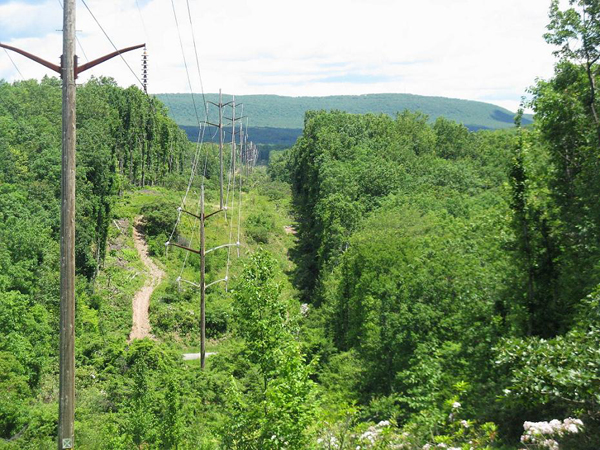
joe myers
The perfect habitat! Wood turtles will nest on the steep sections of the dirt path, and the berries here are plentiful.
During really hot weather they stay closer to the edge of the woods and enter the field on the shady side, and will favor water a lot more – often entering it before 1 p.m. at times, and strangely they do very little feeding in the water, unless they find a drying puddle full of stranded tadpoles, or happen to be in a clear body of water when a heavy rain brings the worms up.
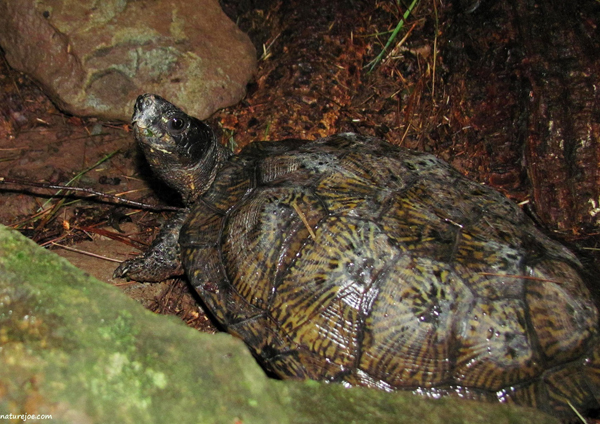
joe myers
Often when sitting among stones scattered along the edge of a field, they will blend right in among them.
Water is very important to the Wood turtle for two reasons. They both hibernate and mate there. As the days of Autumn grow cooler, the wood turtles soon leave their fields behind for another year, and move close to the streams and creeks. At this time they are pretty much done with food and feeding, and once the sun drops low and there's a chill in the air they will enter the still portions of the stream.
In the morning when the sun shines brightly they will leave the water and crawl to a dry location usually among the dead reeds and grasses fairly close to the creek and soak up as much sun as possible, and will re-locate to follow the sun as it moves across the sky.
Once the sun has left they will return to the water, and usually until cold weather arrives they will pick a sunny section of creek for this very purpose, and also when they're in the water they remain quite active there despite the chilly temperatures, and will breed here as well.
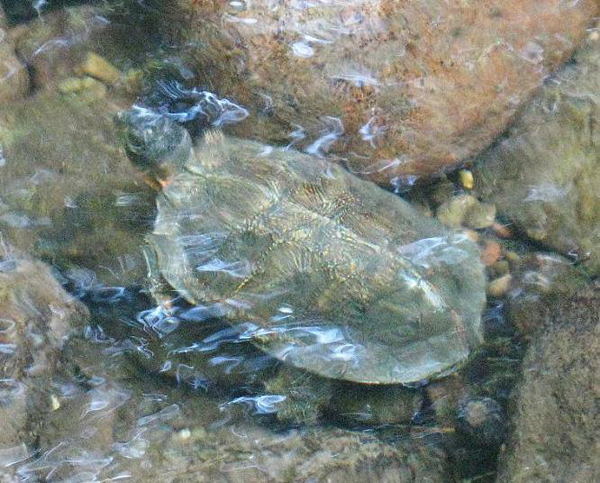
joe myers
This wood turtle is entirely submerged in this mountain stream.
About the time the last leaves drop and the first snows begin, the turtles leave the area described above and head for their true areas of brumation. Flowing water is a must for them it seems, and in the little mountain stream we just took a look at, they work their way to the deeper parts and will find an area of very little current and literally crawl up under the bank and out of sight. They often position themselves in such a way to where breathing is easy for them. All they need to do usually is put their head up for air, and during heavy rains it's no problem for them as they simply hold their breath until the water level returns to normal in a couple days or so.
They often suspend themselves among underwater roots beneath the bank to avoid being washed away. They will also use larger mud-bottomed springs for brumation, and will bury themselves beneath the mud for months on end. Wood turtles seem to avoid still water altogether (ponds that freeze over that is), but if there's an inflow either through a pipe or a small stream, they may spend the winter here too – often accompanied by a painted turtle (Chrysemys sp.) or two, and in some cases they will hibernate by suspending themselves in log jams over deep areas of fairly calm sections of a small creek.
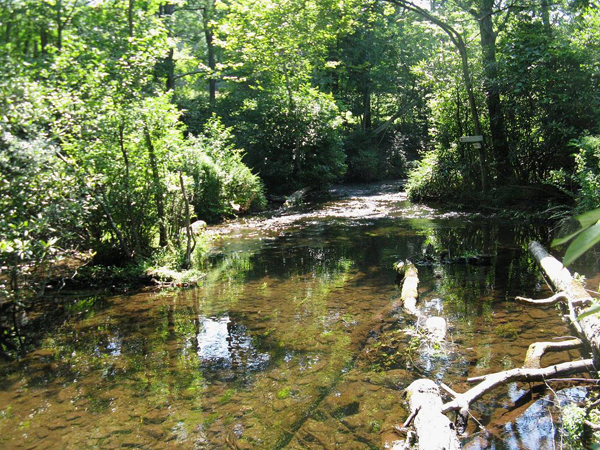
joe myers
Wood turtles spend nearly half their life in creeks such as the one shown here.
Usually around April they reappear and will quickly take to the sun. They seek a wind-protected spot and will bask daily until the trees and grasses show some green on them, then it's off to the fields once again for the summer. As for nesting, they usually do so during the late afternoon or evening, preferably when it's raining.
A cold rain they will avoid, but a sharp early-June thunderstorm will bring many females to the nesting field where the females will often lay their eggs only inches away from where she laid them the year before. Because of the nature of the soil they use in their habitat for egg-laying they often strike a rock or two which will cause them to abandon the attempt, and the following night they will try again. The babies usually hatch in mid-late August and will wander off toward a weedy/grassy area near a seep or a spring and will remain there until brumation. The very young ones usually live at the edge of the forest among the thick vegetation that borders the fields, feeding on insects and small slugs.
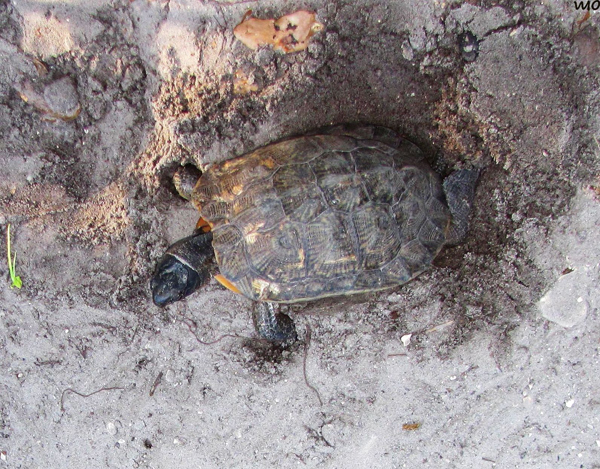
joe myers
Female wood turtles will often lay their eggs only inches away from where she laid them the year before.
As a closing note, some folks may be tempted to go grab one out of the wild. My advice is DON'T! For one they probably won't live very long, and for two, they're illegal! These are protected throughout their range and habitat destruction and mowing are to blame. I have seen great numbers chopped to pieces in hayfields, and if you own a hayfield please cut during the late-afternoon while the turtles are getting their water, and NEVER cut on a cloudy day. This is when they wander most, and are likely to be hit.
Back in the 1980s I used to live near prime wood turtle habitat in E. Pennsylvania, and sadly because of the encroachment of civilization since then, nearly 90% of this "prime habitat" is gone in that area! Malls, housing developments, golf courses, and other businesses have reduced their habitat to nothing, and the open, flat fields they call "home" are also catching the eye of developers much to the detriment of this beautiful turtle. If you know of a place where these are still common, please get some nice pictures of them, and please keep the place a secret, and talk to the farmer or land owner about the "protected species" he has living there, and maybe this will change his or her mind about selling it.
"Nature" Joe (Myers) is a nature photographer and has many years of experience with this species. He has been working with groups of people of all ages in an outdoor educational setting since 1986, and can be followed on Facebook https://www.facebook.com/n.joe.myers where his nature photography and time-lapse videos are displayed there publicly.

